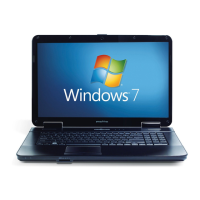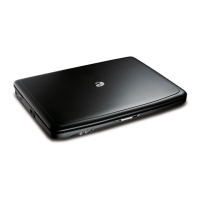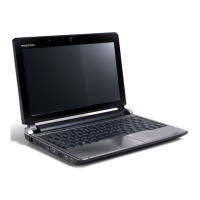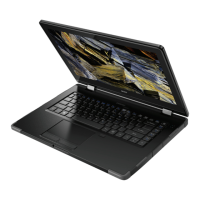Do you have a question about the Acer eMachines Series and is the answer not in the manual?
Read instructions carefully and follow warnings marked on the product for safe operation.
Guidelines for safe use of electrical power, including precautions for cords and outlets.
Lists conditions requiring professional service, such as damaged cords or exposure to liquid.
Instructions for safe usage and storage of Lithium-ion batteries to prevent leakage or damage.
Warning about invisible laser radiation when the enclosure is open.
Turn off wireless devices in specific conditions to ensure safety and prevent interference.
Maintain separation from pacemakers to avoid potential interference with their function.
RF signals can affect vehicle electronic systems; check manufacturer for compatibility.
Switch off the device in areas with explosive atmospheres to prevent fire or explosion.
Information on preventing eyestrain, headaches, and musculoskeletal disorders from computer use.
Tips for adjusting monitor, footrest, and posture for maximum comfort.
Tips for developing relaxing and productive computer use habits.
Recommendations for resting eyes, focusing on distant points, and blinking frequently.
Guidelines for protecting the computer from environmental factors, physical damage, and dirt.
Proper handling and maintenance of the AC adapter and its cord to prevent damage or hazards.
Setting up Supervisor, User, and Boot passwords for enhanced security.
Troubleshooting steps for when the computer does not power on or boot up.
Steps to resolve issues where the screen remains blank after powering on.
Guide to restoring the computer to factory defaults using disk-to-disk recovery.
Recommended actions based on the situation when the battery-low warning appears.
Step-by-step guide for installing or upgrading RAM memory modules.
Steps to enable the disk-to-disk recovery feature within the BIOS.
Setting up passwords in BIOS to secure the computer at boot time.
Creating factory default discs and driver/application backup discs.
Procedures for restoring the system from factory default images or backup discs.
Restoring the system to factory defaults or retaining user data.
Steps to prepare for restoring Windows from backup discs, including inserting the first disc.
Following prompts to install Windows from recovery discs and complete the restore.
General advice for diagnosing and resolving common system problems.
Table of common error messages and their recommended corrective actions.
Information on FCC compliance for Class B digital devices and interference.
Guidelines for minimizing human contact with RF energy, including separation distances.
Read instructions carefully and follow warnings marked on the product for safe operation.
Guidelines for safe use of electrical power, including precautions for cords and outlets.
Lists conditions requiring professional service, such as damaged cords or exposure to liquid.
Instructions for safe usage and storage of Lithium-ion batteries to prevent leakage or damage.
Warning about invisible laser radiation when the enclosure is open.
Turn off wireless devices in specific conditions to ensure safety and prevent interference.
Maintain separation from pacemakers to avoid potential interference with their function.
RF signals can affect vehicle electronic systems; check manufacturer for compatibility.
Switch off the device in areas with explosive atmospheres to prevent fire or explosion.
Information on preventing eyestrain, headaches, and musculoskeletal disorders from computer use.
Tips for adjusting monitor, footrest, and posture for maximum comfort.
Tips for developing relaxing and productive computer use habits.
Recommendations for resting eyes, focusing on distant points, and blinking frequently.
Guidelines for protecting the computer from environmental factors, physical damage, and dirt.
Proper handling and maintenance of the AC adapter and its cord to prevent damage or hazards.
Setting up Supervisor, User, and Boot passwords for enhanced security.
Troubleshooting steps for when the computer does not power on or boot up.
Steps to resolve issues where the screen remains blank after powering on.
Guide to restoring the computer to factory defaults using disk-to-disk recovery.
Recommended actions based on the situation when the battery-low warning appears.
Step-by-step guide for installing or upgrading RAM memory modules.
Steps to enable the disk-to-disk recovery feature within the BIOS.
Setting up passwords in BIOS to secure the computer at boot time.
Creating factory default discs and driver/application backup discs.
Procedures for restoring the system from factory default images or backup discs.
Restoring the system to factory defaults or retaining user data.
Steps to prepare for restoring Windows from backup discs, including inserting the first disc.
Following prompts to install Windows from recovery discs and complete the restore.
General advice for diagnosing and resolving common system problems.
Table of common error messages and their recommended corrective actions.
Information on FCC compliance for Class B digital devices and interference.
Guidelines for minimizing human contact with RF energy, including separation distances.
| CPU | Intel Celeron, Intel Pentium, or AMD Athlon (varies by model) |
|---|---|
| RAM | Up to 4GB |
| Storage | Up to 500GB HDD |
| Display Size | 15.6 inches (varies by model) |
| Operating System | Windows Vista, Windows 7 |
| Graphics | Integrated Intel GMA or AMD Radeon (varies by model) |
| Optical Drive | DVD-RW |
| Networking | Wi-Fi 802.11b/g/n, Ethernet |
| Ports | USB 2.0, VGA |
| Battery | 6-cell Li-ion |











